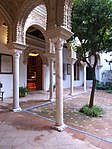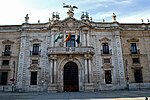Casa de Murillo

The Casa de Murillo is a historical house in Seville, Andalusia, Spain, at number 8, calle Santa Teresa, in the historic Barrio de Santa Cruz. It was the home of the painter Bartolomé Esteban Murillo (1617–1682) in the latter years of his life. The building has two storeys and a central patio (courtyard) with columns. A house museum was established there in 1972 and opened to the public in 1982, the tricentenary of Murillo's death. The museum attempted to recreate a 17th-century ambience. However, in 1998, most of the building was converted into offices for the Andalusian Council of Culture, leaving only a small museum space that is used for temporary exhibitions.
Excerpt from the Wikipedia article Casa de Murillo (License: CC BY-SA 3.0, Authors, Images).Casa de Murillo
Calle Santa Teresa, Seville Casco Antiguo
Geographical coordinates (GPS) Address Nearby Places Show on map
Geographical coordinates (GPS)
| Latitude | Longitude |
|---|---|
| N 37.385694444444 ° | E -5.9890277777778 ° |
Address
Calle Santa Teresa 8
41004 Seville, Casco Antiguo
Andalusia, Spain
Open on Google Maps











